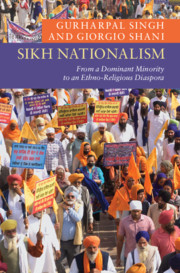Book contents
- Sikh Nationalism
- New Approaches to Asian History
- Sikh Nationalism
- Copyright page
- Contents
- Maps
- Figures
- Tables
- Acknowledgements
- Abbreviations
- Glossary
- Introduction
- 1 Understanding Sikh Nationalism
- 2 Sikhism and the Sikhs up to the 1890s
- 3 The Emergence of Modern Sikh Nationalism, 1880s–1930s
- 4 The Partition of India and the Sikhs, 1940–1947
- 5 The Indian Union and the Sikhs, 1947–1984
- 6 Militancy, Antiterrorism and the Khalistan Movement, 1984–1997
- 7 Sikh Nationalism in the Age of Globalisation and Hindutva, 1997 to the Present
- 8 The Diaspora
- Conclusion
- Timeline
- Appendix: Anandpur Sahib Resolution
- References
- Index
- New Approaches to Asian History
5 - The Indian Union and the Sikhs, 1947–1984
Published online by Cambridge University Press: 19 November 2021
- Sikh Nationalism
- New Approaches to Asian History
- Sikh Nationalism
- Copyright page
- Contents
- Maps
- Figures
- Tables
- Acknowledgements
- Abbreviations
- Glossary
- Introduction
- 1 Understanding Sikh Nationalism
- 2 Sikhism and the Sikhs up to the 1890s
- 3 The Emergence of Modern Sikh Nationalism, 1880s–1930s
- 4 The Partition of India and the Sikhs, 1940–1947
- 5 The Indian Union and the Sikhs, 1947–1984
- 6 Militancy, Antiterrorism and the Khalistan Movement, 1984–1997
- 7 Sikh Nationalism in the Age of Globalisation and Hindutva, 1997 to the Present
- 8 The Diaspora
- Conclusion
- Timeline
- Appendix: Anandpur Sahib Resolution
- References
- Index
- New Approaches to Asian History
Summary
In this chapter, we examine how, less than forty years after accession to the Indian Union, the Sikhs’ uneasy accommodation erupted into armed conflict. The chapter begins by reviewing the post-independence constitutional framework by focusing on religion and the rights of religious minorities. It then assesses how Nehru and his daughter, Mrs Indira Gandhi, managed ethnic tensions in the Punjab. We examine how opposition to the Centre’s policies was sustained by the SAD by the campaign for a Punjabi Suba (a Punjabi-speaking state), that was conceded in 1966 without the state capital of Chandigarh and some Punjabi-speaking areas. The chapter then evaluates the Centre’s policies in the Punjab and the SAD’s response in adopting the Anandpur Sahib Resolution (ASR), which called for autonomy and sovereignty with radically reduced powers of the Centre. It concludes by reflecting on the autonomy movement in 1982–4 that ultimately led to Operation Blue Star.
- Type
- Chapter
- Information
- Sikh Nationalism , pp. 110 - 131Publisher: Cambridge University PressPrint publication year: 2021



